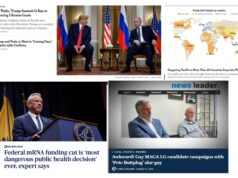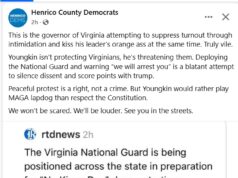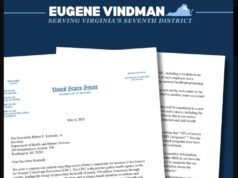by Russell Max Simon (Lowell’s note: I’d argue that these lessons apply to Virginia 2017 as well…)
The Lessons of Trump-Clinton Can Be Applied to Candidate Selection for 2018
TL;DR:
- Candidates don’t necessarily have to be local stalwarts with a lot of experience or money. The 2016 campaign showed traditional measures of candidate strength to be less important than conventional wisdom has argued.
- Activists should instead prioritize candidates with a compelling personal narrative and an alternative story to tell about America that is capable of countering the narratives advanced by Trump and the GOP.
- Democrats need to begin identifying and supporting a new generation of leaders who not only can win in 2018, but who will grow into the liberal leaders of the future.
We’ve reached that point in American politics, ahead of schedule, where campaign season simply does not stop. It only breaks for a brief mourning period, before continuing on.
At a meeting of Democratic activists in Silver Spring, Maryland, yesterday, I witnessed this new reality first-hand. One of many local “huddles” born out of the Women’s March, the meeting was the kind of gathering we’re more used to seeing six or eight months from now, not while snow is still falling in an off year.
There were working groups dedicated to upcoming races, including Maryland Governor and Virginia’s 10th Congressional District. Activists are already out there registering voters and gathering email addresses, provoking incumbent GOP candidates, experimenting with lines of attack, and perhaps most importantly, searching for strong opposition candidates.
It appears Democrats may finally be getting the message: midterms matter. Two months into the Trump presidency it’s fairly clear the only forces acting as a check on the Executive are its own lack of focus, a generalized incompetence, and a judiciary gratefully intent on at least pumping the breaks.
The GOP-controlled Congress has little appetite investigating, no matter how egregious its conflicts of interest, no matter how frightening the potential rabbit holes of Russian influence may be. As that great guardian of Constitutionalism, Rand Paul, said recently: “I just don’t think it’s useful to be doing investigation after investigation, particularly of your own party…I think it makes no sense.”
Considering the current state of affairs, it’s no wonder us liberals are so eager to start running candidates. The sooner we can see a light at the end of the all-GOP, all-the-time tunnel, the better we’ll feel about surviving the next four years. And having an actual candidate to help light the way only makes the path more clear.
But activists should take a breath before jumping at the first allegedly strong candidate that pops into view. Understandably, it doesn’t feel good to only be against things all the time (I don’t know how Republicans did it for so long!). It’s comforting to know there’s a candidate into whom all this energy can henceforth be channeled. And so the candidate searches have begun, far far earlier than anyone is used to.
The question is: what should Democratic activists be looking for?
The Lessons of 2016
Amid the constant stream of stories about Russian meddling, Fake News, resurgent nationalism, and Hillary’s failure to predict what almost no one saw coming, not enough attention has been given to the plain fact that Trump won with almost no traditional campaign infrastructure.
The 2016 election exposed much conventional wisdom as likely to be false, but among the most consequential items for future elections was the idea that traditional measures of campaign strength like fundraising, experience, and ground-game have anything at all to do with outcomes.
Ezra Klein at Vox.com has said his team was building a sort of “organizing-penalty” into the polling numbers, revising Hillary’s margin upward to account for her campaign’s presumably superior organization. Ooof.
Another piece of conventional wisdom – that all politics is local – is almost certainly wrong as well. Recent history, including 2016 but other races as well, have shown that Congressional candidates rise and fall on the strength of the incumbent president. In 2010 it was a national debate over healthcare reform that drove a Tea Party-led takeover. Midterms historically have favored Republicans because their candidates rely on more consistent voters, while Congressional races during a Presidential election year have tended to help Democrats, whose excitement for candidates at the top of the ticket overflows to down-ballot races.
With an all-news-cycle-consuming reality TV star in the White House, it’s a fairly sure bet the 2018 midterms will be all about the man on top.
Implications for Candidate Selection
It requires no special vision to suggest that 2018 will be a referendum on Trump, but the implications of that prediction for candidate selection are actually quite profound. Historically, national interest groups and political organizations like the Democratic Congressional Campaign Committee have looked to candidates with strong roots and established constituencies in the communities they are running to serve. This criteria is almost certainly over-indexed for in the candidate selection process, and will be even less relevant in 2018. (The same goes for out-of-state activists, for that matter: when retaking Congress promises to be such an effective check on Trump, it shouldn’t come as any big surprise when both out of state money and out of state volunteers pour in to help out).
Exhibit A is of course Hillary Clinton herself, who moved to New York in order to run for the Senate. Predictably, she was accused of being a carpetbagger, but she compensated by embarking on her famous “Listening Tour.” The press were a bit confused, but the tour worked. Hillary listened (apparently the thing she does best) to the people of New York, and she won the race. Clinton went on to represent the state well despite being a newcomer there, and was reelected by a large margin.
If 2018 is going to be all about Donald Trump, we need to look beyond whomever simply has the longest local resume to candidates a little more outside the box. State representatives, county executives, and the like may have put in their dues, but by now it should be pretty obvious that being next in line is not in and of itself what people care about.
Running For Office Is Storytelling, and Republicans Have Always Been Better At It
Republicans have always been pretty clear about what they stand for: less government and lower taxes. Then along came Donald Trump. He not only captured the traditional Republican base, but he added to it with a new story: America doesn’t win any more. It used to be great, but now it’s not. He knew who to blame, and told everyone he was going to fix it (details be damned). It was a winning story.
Whoever runs against incumbent GOP congresspeople will have to be skilled at telling an alternative story. Democratic messaging can’t just be a collection of policies uniting disparate constituencies, all concerned about their own causes and issues. We can’t add environmentalists to social justice activists to labor to teachers and lawyers and artists and hope to win. That’s why adherence to Progressive orthodoxy is the next thing that is likely being over-indexed in candidate selection.
The 2016 taught us that “the most acceptable conservative candidate” is not necessarily who will walk away with the GOP nomination for president. Conversely, Democratic activists should be less interested in finding candidates who check all the progressive issue boxes, and more interested in finding candidates with a compelling story, both personally, and about the country. If the story resonates, they will win.
Looking Beyond 2018: A New Generation of Democratic Leadership
Democrats have had their head in the sand for a while about the future of their party. Obama’s two big wins obscured the fact that Democrats have been gutted at literally every other level of elected office. Democratic leadership right now is old (and white), almost across the board.
Activists should be looking at candidates, therefore, not just with eye toward 2018, but with eye toward the next 20 years of electoral politics. I love Nancy Pelosi as much as the next liberal; in the dark times, when I am yearning for the parliamentary system that could moderate our most extreme tendencies, and drive our parties to work together and earn the respect of their colleagues rather than engage in zero-sum electioneering, I have fantasized about the four years, from 2006 – 2010, that Pelosi would have effectively served as our very own American Prime Minister, building coalitions and advancing a liberal agenda.
But make no mistake: liberal activists would be doing themselves and their movement a disservice by under-indexing the potential long-term benefits of electing young candidates. The next Representative, Senator, or Governor of your state may very well be a Millennial, and part of the liberal activist’s task should be to begin identifying and supporting a new generation of Democratic leadership.














![Monday News: Trump’s Lunacy Pushes China, Russia, India, etc. Together; “Happy Labor Day. Donald Trump and Elon Musk Are Screwing Workers.”; “Where is the [media’s] intense focus on Trump’s failing health?”; ““Trump says he is not a dictator. Isn’t he?”](https://bluevirginia.us/wp-content/uploads/2025/09/montage0901-100x75.jpg)